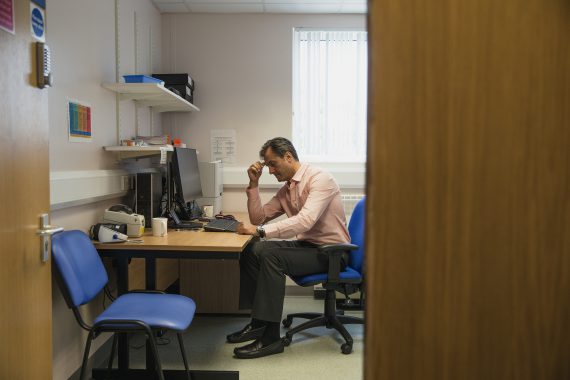New approach proposed to reduce burnout at GP practices

A greater use of team interventions at GP practices could help prevent burnout, according to a recent guide aimed at those working in the health and care sector.
The report from the Society of Occupational Medicine (SOM) said that a new approach was needed to tackle the particularly high rates of burnout experienced by healthcare workers that can damage their mental and physical health.
It pointed to the 2022 NHS workforce survey, which found that 34% of participants reported feeling burned out because of their work and 37% found it emotionally exhausting. And, research showed, GPs were particularly vulnerable to burnout.
The evidenced-based report, Burnout in healthcare: risk factors and solutions, recommends employers take a multi-level approach where strategies are implemented at organisational, individual and rehabilitation/ treatment level.
However, reviews of studies conducted in the healthcare sector have highlighted evidence for the effectiveness of organisational interventions compared with individual interventions.
Interventions at practice level include strategies to prevent burnout by, for example, identifying and minimising the organisational risk factors for burnout.
The report says that most initiatives that aim to reduce the risk of burnout focus on the individual, yet ‘the most effective way to reduce the risk of burnout is prevention’.
A key recommendation is to make greater use of team-level interventions, starting with staff being able to identify and monitor signs that someone at work is struggling (see box below).
The report said: ‘There is evidence that co-workers are adept in detecting early signs of burnout in others, so a group of trusted colleagues is well placed to monitor each other for symptoms.’
The guide also said peer mentoring had ‘particular promise in supporting the mental wellbeing of healthcare professionals’ as it provided an opportunity to talk to others in a similar situation.
Peer support can take place in informal groups or as a more formal approach, such as the Trauma Risk management (TRiM) model, which is a psychological risk assessment and peer support framework originally developed and used in the UK armed forces.
It also went on to highlight the need to see burnout as a developmental process in response to challenging working conditions, rather than a set of symptoms to be ‘treated’.
Employees should be involved in shaping the initiatives adopted by a workplace, it said.
And, finally, it warned, ‘quick-fix’ solutions that are not evidence based, such as some wellbeing apps, should be avoided by employers.
‘Wellbeing apps for smartphones have become particularly popular,’ the report said. ‘While apps based on established models and strategies can be effective, many are ineffective or only provide minimal benefits.’
Professor Gail Kinman, co-author of the report, said: ‘Burnout is an extremely serious matter that impacts workplaces across Britain, but it is a particular problem in healthcare settings.
‘We know that doctors, nurses, and other healthcare professionals are more likely than most to experience burnout and therefore it is vitally important that we take urgent action.’
She added that the ‘real and practical steps’ recommended in the report would help employers fight burnout.
Signs of struggle to watch out for in colleagues
- Changes in behaviour and attitudes
- Easily irritated and angry
- Emotional outbursts
- Confused and lacking in focus
- Intolerant and impatient; being critical of others
- De-sensitised and lacking empathy
- Uncooperative; more rigid or resistant
- Negative and disengaged
- Quiet and withdrawn
- Missing meetings and deadlines; deteriorating quality/quantity of work
- Absenteeism; arriving late/leaving early
- Regularly sending emails ‘out of hours’
- Change in communication style
- Avoiding social contact
- Looking tired and ‘zoning out’
- Change in appearance
Source: Burnout in healthcare: risk factors and solutions (Society of Occupational Medicine, 2023)
A version of this story was first published by Pulse’s sister title Management in Practice
Pulse July survey
Take our July 2025 survey to potentially win £1.000 worth of tokens

Visit Pulse Reference for details on 140 symptoms, including easily searchable symptoms and categories, offering you a free platform to check symptoms and receive potential diagnoses during consultations.
Related Articles
READERS' COMMENTS [4]
Please note, only GPs are permitted to add comments to articles











Time in front of patients, demand and management atmosphere are critical parameters. Need I say more
May I refer people back to 2010 article in Pulse: https://www.pulsetoday.co.uk/news/practice-personal-finance/fighting-back-against-burn-out/
Plus ca change and all that…
It really was never this bad, society seems to be sick, patients appear disgruntled, obsessed with non-existent pathology and very distrustful of professionals. Any disaffection must be due to undiagnosed ADHD/ Autism. I suspect all of above can be traced back to social media (and a government that does not care about the populace at large)
Of the NHS workforce, 34% feel burned out: 37% feel emotional exhaustion: –
DSM-V, WHO & ICD-11 all describe ‘Burnout’ as a legitimate medical diagnosis, encompassing depleted energy, exhaustion, negativity, cynicism, and reduced productivity.
If the 34% do fulfil the diagnostic criteria, then should those medical professionals be tending to ‘patients’?
Or, as patients themselves, be ‘signed-off’ from their work employment via on a medical certificate of illness?
“Can You Claim Disability for “Burnout” or Intense Workplace Stress? March 06, 2021
“If you are struggling and looking for short-term disability for burnout employers are required to give sick leave as a reasonable accommodation”.
“Your employer can require a doctor’s note and may require that you submit new notes every three to six months”.
And from Canada: – “In January 2018, Ontario implemented a new policy allowing claims for chronic mental stress to be considered a workplace injury”.
So, “I’ll sign yours if you sign mine”.